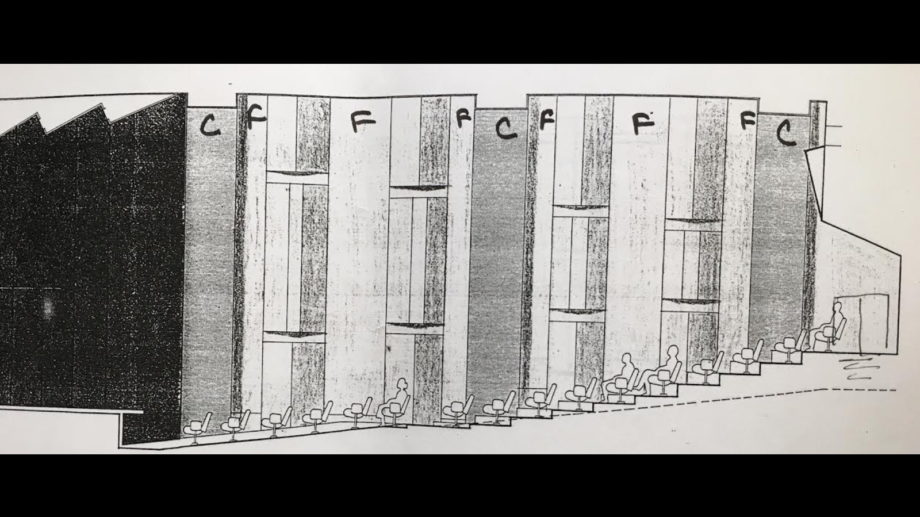A 1991 program guide for the opening events at the Walter Reade Theater states, “For all our programs, we will guarantee the finest, most technically accurate presentation possible, so that each work can be enjoyed in a manner as close as possible to that envisioned by its creator.” This year marks the 25th anniversary of the Film Society of Lincoln Center’s Walter Reade Theater, and the above statement holds true for the mission of the theater, as well as for the Film Society’s programming and commitment to film presentation and appreciation.
An institution dedicated to showcasing film as an art, the Film Society was founded in 1969. For the next two decades, it would remain true to that commitment via the annual New York Film Festival and New Directors/New Films festival, as well as its yearly Chaplin Award Gala tribute to notable talents in the industry. Prior to building the Walter Reade and establishing offices in the Samuel B. and David Rose building on West 65th Street, Film Society employees worked in an office below Lincoln Center’s Henry Moore pool, precisely where the Elinor Bunin Munroe Film Center now sits. In 1985, plans for its own film venue were formally adopted by the Film Society’s Board of Directors, to be named the Walter Reade Theater after a pledge by the Walter Reade Foundation. However, it was not until the 1991 ribbon-cutting of the Walter Reade that the Film Society finally had a home for year-round programming.
The Walter Reade Foundation was a chain of movie theaters, which had started as a sole theater in New Jersey that expanded to areas around the state, as well as New York City, upstate New York, and Boston. The president was Walter Reade Jr., whose father was known for creating beautifully maintained single-screen movie theaters from the golden age of Hollywood. Upon his father’s passing, Walter Reade Jr. took over the organization and proceeded with a mission to bring foreign and specialty films to American theaters. After his death in a skiing accident in 1973, the organization pledged the naming gift to the Film Society in his honor.
After partnering with Lincoln Center for the theater, the Film Society faced a challenge in designing it, as it was also intended to accommodate occasional small chamber music shows. Acoustics for film are quite different from those for music, so the venue was ultimately designed for multi-use with cloth-wrapped fabric panels on the wall (absorbent for film acoustics), which could be removed to reveal reflective wood paneling for music performances.
French architect Igor Hilbert, who had recently designed a theater in Provence for similar film and music functionality, was chosen for the project. But he was only able to design the frame before having to depart for France. Lew Davis, of Davis, Brody & Associates, the firm that designed the rest of the Rose building, took over. One of the remaining issues was that the theater needed lighting fixtures on the walls, but they couldn’t reflect any light from the screen when a film was showing. Artist Joy Wulke, who made lighting fixtures with cracked glass, was selected to create sconces, which solved the problem.
The result of all this was a magnificent theater, equipped with state-of-the-art projection and sound quality, a 35”x19” screen, and 268 seats. Eradicating bad sight lines was a key concern in the theater’s design, and with step seating on most rows, after an eight-degree slope in front, there isn’t a bad seat in the house. Additionally, a floating ceiling was added for further sound-proofing, since the new theater was located below the dance studios for the American Ballet School. Vincent Canby of The New York Times stated that the Walter Reade “may well be the most inviting new movie house to open in New York in years.”
The first footage was projected in the new theater on November 22, 1991: the helicopter sequence from Francis Ford Coppola’s Apocalypse Now, projected to an awe-inspired staff. Weeks later, the Walter Reade opened for four special screenings for donors of the theater. The series began on Tuesday, December 3, 1991, with Pedro Almodóvar’s High Heels, and continued until December 6 with Orson Welles’s Othello, Woody Allen’s Shadows and Fog, and Errol Morris’s A Brief History of Time. The ribbon-cutting of the Walter Reade took place on December 9, followed by the first public screening series: “Great Beginnings,” consisting of 35 debut films from renowned filmmakers such as Stanley Donen, Almodóvar, and Jim Jarmusch. Featuring films from 1989–1991, “Italian Cinema Now” simultaneously ran, already demonstrating the Film Society’s goal of creating connections between films of all backgrounds. Later that opening month, a series of Marlene Dietrich films honored the icon on the occasion of her 90th birthday.
The Walter Reade Theater was built to support film in a variety of ways, but ultimately the goal was to establish film as an art form. The theater planned to show diverse programming, with up to four different kinds of films a day, intermingling various voices in contemporary world and classic cinema, as well as documentary, experimental, and independent films. Thanks to the continuing vitality of the Walter Reade Theater, the Film Society continues this tradition to this day.
Thank you for your support of the Walter Reade Theater on its 25th anniversary. By donating to our Kickstarter campaign, you’ll be contributing to the theater’s unique history and place in film culture and ensuring that all the things it stands for will continue for decades to come.



